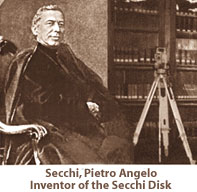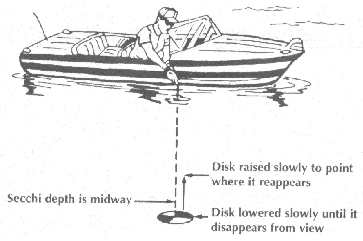Disclaimer & Copyright Notices; Optimized for the MS Edge

Secchi disk (SD)
Soil & Water Conservation Society of Metro Halifax (SWCSMH)
Updated: September 23, 2020 
(.............
in memory of a valued deceased member, Lcdr. Tom Willdey of Cadets Canada;
photo on right when he was sampling Paces Lake along the eastern HRM; and a link embedded in it)
Contents:
Introduction
The Secchi disk transparency measurement is
perhaps one of the oldest and simplest of all measurements. But there
is grave danger of errors in such measurements where a water telescope
is not utilized, as well as in the presence of water color and
inorganic turbidity (Vollenweider and Kerekes, 1982).
Value of Secchi disk data:
Relationships between Secchi depth and the
concentration of algal chlorophyll pigments do exist. However these
relationships are not universal. If silt or dissolved color, not algae,
causes the turbidity in the lake, the algal abundance will be
overestimated.
Davies-Colley et. al. are quoted
by Carlson as having found that measurements taken with the disk are no
less precise than other water quality measurements. Secchi depth is
even a more precise measurement than turbidity, which is the preferred
substitute measure.
"In bringing
attention to the Secchi disk, volunteer programs have forced a
thoughtful reconsideration of the utility of the disk in limnology. It
is a one hundred and thirty year old instrument, but it is enjoying a
scientific renaissance, largely thanks to volunteer monitoring." (Carlson, 1995).
History
 The Secchi disk is perhaps the oldest, the most durable, the most
controversial, and potentially indispensable tool of the contemporary
limnologist. "Secchi" rhymes with etch-e, not ekki. Secchi (1818-1878)
was not an oceanographer, but an astrophysicist. The first Secchi disk
was lowered from the papal steam yacht, l'Immacolata Concezione in the
Mediterranean Sea on April, 20, 1865. On that April day, Fr. Peitro
Angelo Secchi, the scientific advisor to the Pope initiated a series of
seven experiments over a six week period at the request of Commander
Cialdi, head of the Papal Navy. Marine disks are 40 or 50 cm (16 to 20
in) in diameter, but, in lakes the standard has become 20 cm (8 in). (Carlson, 1995)
The Secchi disk is perhaps the oldest, the most durable, the most
controversial, and potentially indispensable tool of the contemporary
limnologist. "Secchi" rhymes with etch-e, not ekki. Secchi (1818-1878)
was not an oceanographer, but an astrophysicist. The first Secchi disk
was lowered from the papal steam yacht, l'Immacolata Concezione in the
Mediterranean Sea on April, 20, 1865. On that April day, Fr. Peitro
Angelo Secchi, the scientific advisor to the Pope initiated a series of
seven experiments over a six week period at the request of Commander
Cialdi, head of the Papal Navy. Marine disks are 40 or 50 cm (16 to 20
in) in diameter, but, in lakes the standard has become 20 cm (8 in). (Carlson, 1995)
Record Secchi depths:
In absolutely pure water, the theoretical
maximum value would be between 70-80 meters (230-262 ft). The deepest
published Secchi disk reading was 66 meters (217 ft) in the Sargasso
Sea. In lakes,, a record depth of 44 m (144 ft) was obtained in Crater
Lake using a 1 m diameter disk, and at the same time, a reading of only
39 meters (128 ft) was recorded with a 20 cm disk. The record for the
smallest Secchi depth recording was 1-2 cm (0.4-0.8 in) in Spirit Lake,
Oregon, after the eruption of Mt. St. Helens. Perhaps the strangest
unofficial record for shallow Secchi depths should be given to Bob
Kortmann, who, lowering his disk through foam generated by a blue-green
die-off, reported a Secchi depth of minus 5 inches; the disk
disappeared before ever reaching the water!
The record for the greatest
number of Secchi readings in a single 24 hour period probably is held
by volunteer monitor, Gerrit L. Verschuur PhD, who has taken 532
measurements on May 20, 1996 at Garner Lake, Tennessee before sunset (cf. Verschuur, 1997).
A proper method of taking A Secchi disk reading
(Davies-Colley et. al., 1993)

- Use a disk of the appropriate size for
the clarity range (20 mm for 0.15-0.5 m, 60 mm for 0.5-1.5 m, 200 mm
for 1.5-5 m, 600 mm for 5-15 m), painted matte white or in black and
white quadrants. Use a graduated line, and attach a weight to hold the
line vertical. (Some studies found that, in very clear waters, the disk
disappeared, not because of loss of contrast, but because the disk
became too small to see. Hence the authors are suggesting that by
changing the size of the disk, the apparent size of the disk when it
disappears would remain approximately the same).
- Lower the disk on the sunny side of the boat. A underwater viewer (viewscope) is desirable.
- Allow sufficient time (preferably 2 min) when looking at the
disk near its extinction point for the eyes to adapt completely to the
prevailing luminance level.
- Record the depth at which the disk disappears.
- Slowly raise the disk and record its depth of reappearance.
- The Secchi depth is the average of the depth of disappearance
and reappearance. The readings should be made as near to mid-day as
possible. The water depth should be at least 50% greater than the
Secchi depth so that the disk is viewed against the water background,
not bottom-reflected light.
The Relationship between Secchi Depth and Solar Altitude
(.... with salutations to Verschuur, 1997)
The data showed that on any given
day the apparent (measured) Secchi depth depends on solar altitude.
This relationship has been modeled. A key point in the model is that
the magnitude of the observed Secchi depth is determined by the
trajectory of a beam of sunlight through the water. The model
calculations allow the Secchi depth observed at any date, time, or
geographical location to be normalized to a standard, the value that
would be found with the sun in the zenith. Use of such a normalization
offers the opportunity to accurately quantify and study Secchi depth
variations over time, or differences between lakes in different
geographical locations. Based on the experience gained in this
experiment, several suggestions are offered on how to obtain the most
accurate measurements on any given day.
If one is interested in
accuracy of a few percent, which is achievable if from 6 to 10
measurements are made at any time and averaged, then solar altitude
corrections between lakes must be made before comparsions can be
undertaken in a meaningful manner (cf., Table 4).
The Observations:
Measurements of Secchi depth were undertaken
using a standard 20-cm disk divided into quadrants, with observations
being made from the deck of a pontoon boat about 45 cm above the
surface of the water on the sunny side of the boat. The Secchi depth
was taken to be the depth at which the disk was just visible after
having been moved up and down several times to establish this position.
Data were collected in clusters of 8 measurements spaced at roughly 15-
to 20- minute intervals, both with and without the aid of a viewing
tube (hence 16 measurements per cluster). The tube was a 10-cm-diameter
white PVC pipe open at both ends and inserted in the water to a depth
of 30 cm. The upper end was 57 cm above water level. The experiment was
confined to calm, sunny days. It was also determined that no
statistical difference in apparent Secchi depth existed whether
sunglasses or regular spectacles were worn.
The solar elevation for each
cluster of measurements was determined using Voyager, an astronomy
program for the Macintosh that allows one to set the astronomical sky
at any location, date, and time and then to find the altitude of the
sun with respect to the local horizon.
Secchi Depths and Path Lengths:
![[sd1.jpg]](PIC/sd1.jpg)
![[sd2.jpg]](PIC/sd2.jpg)
Normalization of Secchi Depth data:
The normalization involves multiplying the observed value (ASD) by a scale factor determined from Eqn. 12 above, given by (1+F)/(2F), which then allows the zenith value, ZSD, to be calculated.
The shape of this scale factor as
a function of solar altitude is shown in Fig. 10 below and the
numerical values are given in Table 3 following.
![[sd4.jpg]](PIC/sd4.jpg)
![[sd5.jpg]](PIC/sd5.jpg)
Comparison between geographical locations:
As an example, Table 4 below shows that
significant differences due only to local solar altitude will occur
between lakes at different latitudes. If the latitude is not taken into
account, such differences might be attributed to the properties of the
lake waters.
![[sd6.jpg]](PIC/sd6.jpg)


We salute the Chebucto Community Net (CCN) of Halifax, Nova Scotia, Canada for hosting our web site, and we applaud its volunteers for their devotion in making `CCN' the best community net in the world!

 The Secchi disk is perhaps the oldest, the most durable, the most
controversial, and potentially indispensable tool of the contemporary
limnologist. "Secchi" rhymes with etch-e, not ekki. Secchi (1818-1878)
was not an oceanographer, but an astrophysicist. The first Secchi disk
was lowered from the papal steam yacht, l'Immacolata Concezione in the
Mediterranean Sea on April, 20, 1865. On that April day, Fr. Peitro
Angelo Secchi, the scientific advisor to the Pope initiated a series of
seven experiments over a six week period at the request of Commander
Cialdi, head of the Papal Navy. Marine disks are 40 or 50 cm (16 to 20
in) in diameter, but, in lakes the standard has become 20 cm (8 in). (Carlson, 1995)
The Secchi disk is perhaps the oldest, the most durable, the most
controversial, and potentially indispensable tool of the contemporary
limnologist. "Secchi" rhymes with etch-e, not ekki. Secchi (1818-1878)
was not an oceanographer, but an astrophysicist. The first Secchi disk
was lowered from the papal steam yacht, l'Immacolata Concezione in the
Mediterranean Sea on April, 20, 1865. On that April day, Fr. Peitro
Angelo Secchi, the scientific advisor to the Pope initiated a series of
seven experiments over a six week period at the request of Commander
Cialdi, head of the Papal Navy. Marine disks are 40 or 50 cm (16 to 20
in) in diameter, but, in lakes the standard has become 20 cm (8 in). (Carlson, 1995)

![[sd1.jpg]](PIC/sd1.jpg)
![[sd2.jpg]](PIC/sd2.jpg)
![[sd4.jpg]](PIC/sd4.jpg)
![[sd5.jpg]](PIC/sd5.jpg)
![[sd6.jpg]](PIC/sd6.jpg)